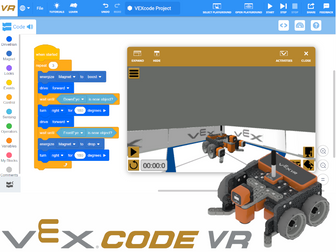
VEX Robotics IQ Curriculum - VEX IQ Robotics Project
The project concentrates on the exploration individually and in teams of the VEX IQ kits, leading to a design and build response. Through the project pupils will be able to develop a keen and focused level of knowledge of robotics design, but in the context of VEX IQ parts. The challenges and learning are based on a US STEM curriculum map, but have been converted to a UK format for the delivery of up to date and modern Design and Technology for primary and secondary school.
* Lesson 01 – Pupils will learn about the need for problem solvers and about the five different types of engineering. They will also develop an understanding of STEM, Engineering and Robotics, including robot control.
* Lesson 02 - Pupils will start to recognize VEX IQ hardware parts and components visually. They will learn hardware functions and will pair their Controller with the Robot Brain.
* Lesson 03 – Pupils will learn about and utilize design process. They will be able to follow instructions to build a functional VEX IQ robot, and troubleshoot and solve problems to improve design.
* Lesson 04 – Pupils will learn about the 6 types of simple machines visually. They will also learn key terminology related to motions, and simple machines make work easier. They will then begin to apply knowledge through build and design activities.
* Lesson 05 - Students will learn key terminology related to Chain Reaction Devices. They will apply knowledge of Simple Machines and Pendulum, and will follow assembly instructions to build a sample Chain Reaction Device.
* Lesson 06 - Pupils will learn about and apply knowledge of Friction. They will learn about and apply knowledge of Centre of Gravity and Mechanical Advantage
* Lesson 07 - Students will learn about DC Motors, and apply knowledge of Gear Ratio. They will learn about Object Manipulation, Lifting Mechanisms, and Drivetrains.
* Lesson 08 - Pupils will utilise and document design process, troubleshoot and solve problems to improve design, and participate in the add up challenge.
* Lesson 09 – Pupils will learn key terminology related to sensors and programming, learn sensor types and capabilities, and utilise design process through programming exercises.
* Lesson 10 - Students will apply knowledge of Simple Machines and Pendulums. Students will review terminology and the design process in building their own Chain Reaction Device. They will then go on to apply knowledge of VEX IQ sensors as well as programming techniques to improve the design.
* Lesson 11 – Pupils will work in teams to build and programme and robot to complete a task using problem solving and by reviewing sensor types and capabilities, design process, and programming challenges.
* Lesson 12 – Pupils will use this lesson to review and document the design process. Students will be use this to improve design and use this when participating in the Add it Up Challenge.
